Vollmer Peak: Birding Hotspot
By Denise Wight
Vollmer Peak in Tilden Regional Park, at an elevation of 1,905 feet, is one of the highest peaks in the Berkeley Hills. With relatively easy access, one can enjoy not only diverse birding but incredible views. On a clear day the Farallon Islands appear to balance on the western horizon, and to the east you can see the outline of the snow-capped Sierra Nevada Range across the Central Valley. Thanks to the foresight of the founders of the East Bay Regional Park District, we are fortunate to enjoy vast areas of open space set aside for public enjoyment at Tilden and many other locations within Alameda and Contra Costa Counties.
Vollmer Peak holds a special place in my heart. I grew up in Orinda, looking up toward the peak. When my father was transferred to the San Francisco Bay Area from Chicago in 1963, he wrote to the family “back east” that we now lived below a mountain. Later we would laugh, knowing these were just hills to the locals.
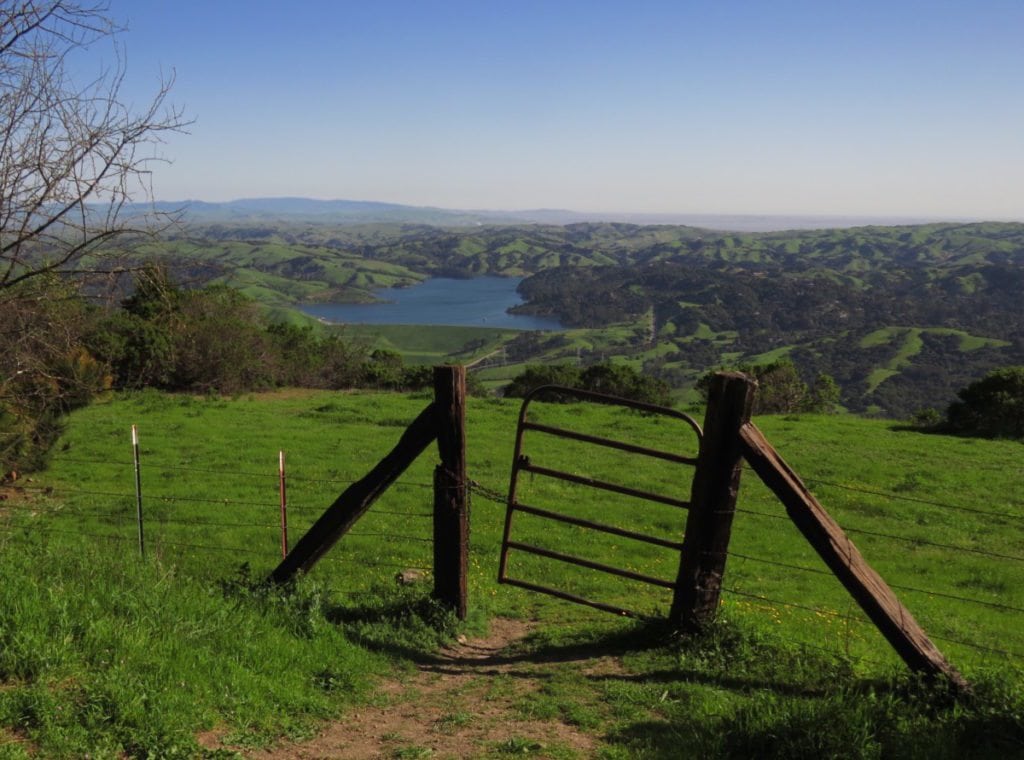
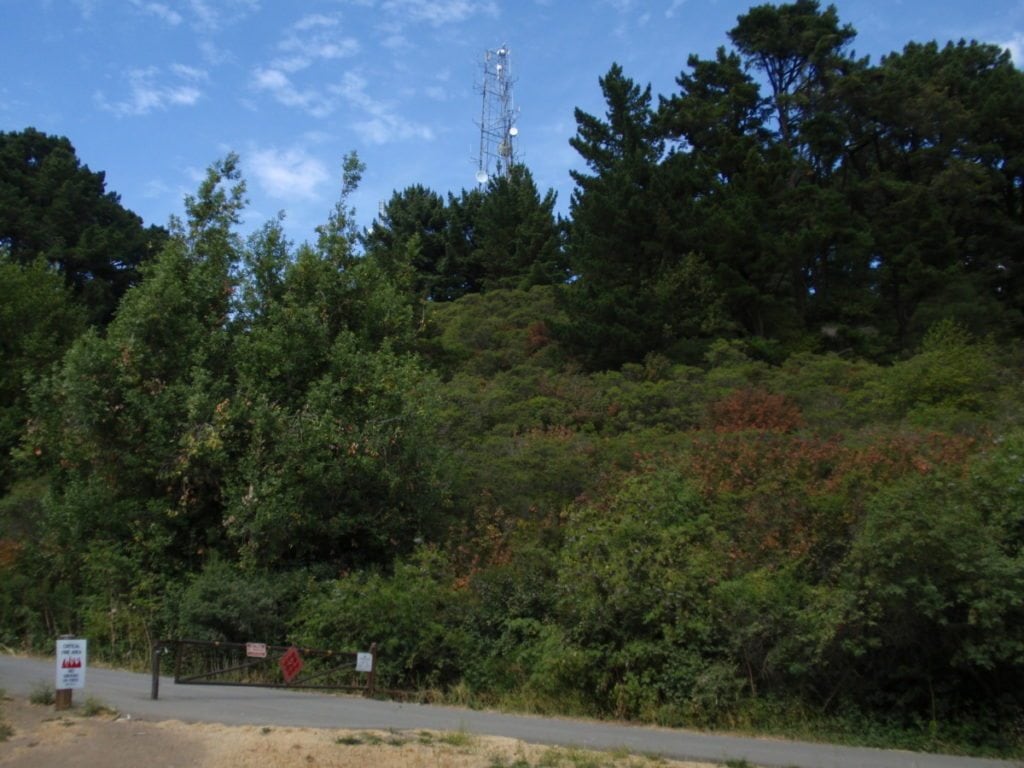
Weather on Vollmer Peak can be incredibly variable. Water drips from vegetation not just during winter and spring rains, but also in mid-July, when the blanket of fog moving in through the Golden Gate hits the peak and soaks the needles of the Monterey pines. There are days when the fog is so thick you can barely make out the silhouettes of California Towhees and Song Sparrows foraging at the edge of the path directly in front of you. The fog moves eastward, cascading over the ridge like a massive waterfall, only to dissipate before it reaches the valley below.
Some old maps show the original name as “Bald Peak.” The name was changed to Vollmer Peak in honor of August Vollmer, an innovator in police professionalism and the first police chief of Berkeley, who loved the outdoors and was actively involved with East Bay Regional Parks in its early years.
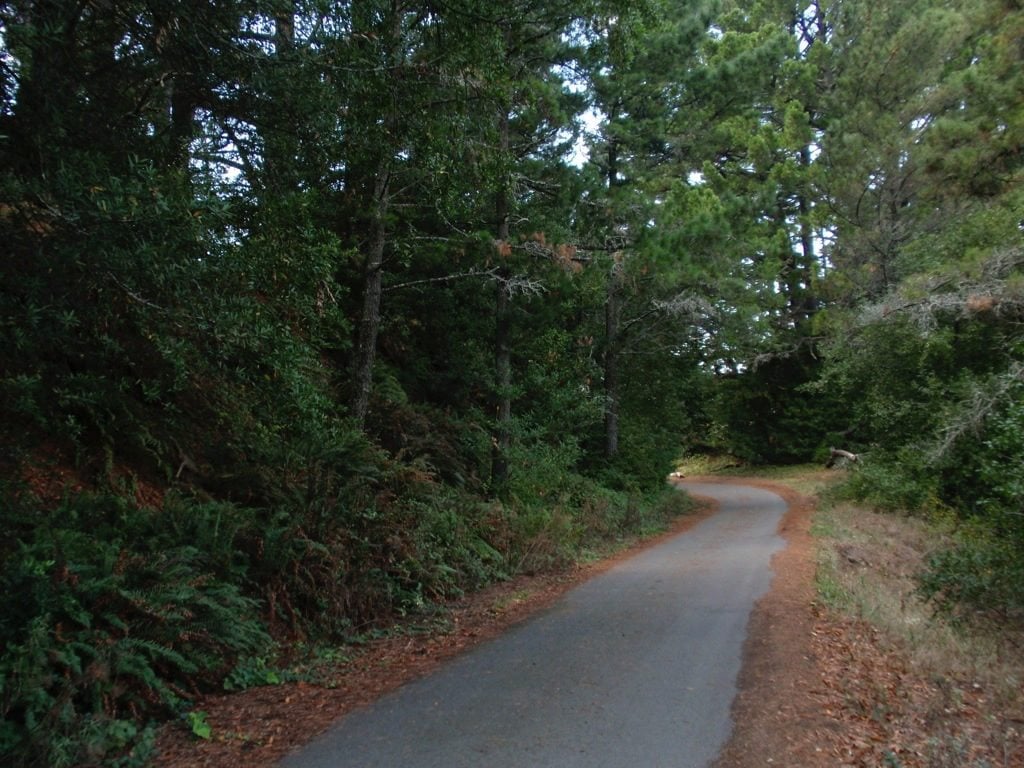

Bird diversity is good on Vollmer Peak and surrounding areas. eBird lists Vollmer Peak as a hotspot with 151 species recorded to date. Habitat around the peak and along the trail to the north includes oak woodland, scrub, pines, eucalyptus and a variety of planted exotics and native plants, with private pastures and grasslands to the east. When the Ohlone tribes inhabited this area, the habitat on Vollmer Peak was treeless grasslands, maintained by regular burning for hunting and food-collecting purposes. Spanish sheep herders and local ranchers also burned the ridge until the mid-1930s. Back then, you would not have found many of the tree- and scrub-loving species we see today.
Trails around Vollmer Peak can be reached from various locations, but the easiest access is from the “Trailhead Parking” lot beyond the Steam Trains. Interesting bird species can often be found year-round nearby. Listen and look for Song Sparrow, Wrentit, Purple Finch, and California Thrasher on the hillside directly above the parking lot. In years when Varied Thrushes are numerous, they may be found in the California bay laurels at the beginning of the Vollmer Peak Trail, at the far end of the parking lot. Red-breasted Nuthatches forage in the Douglas firs that grow at the edge of the parking lot. Check them in winter for mixed-species foraging flocks. Some winters, Red Crossbills can be seen and heard in these trees, associating with Pine Siskins.
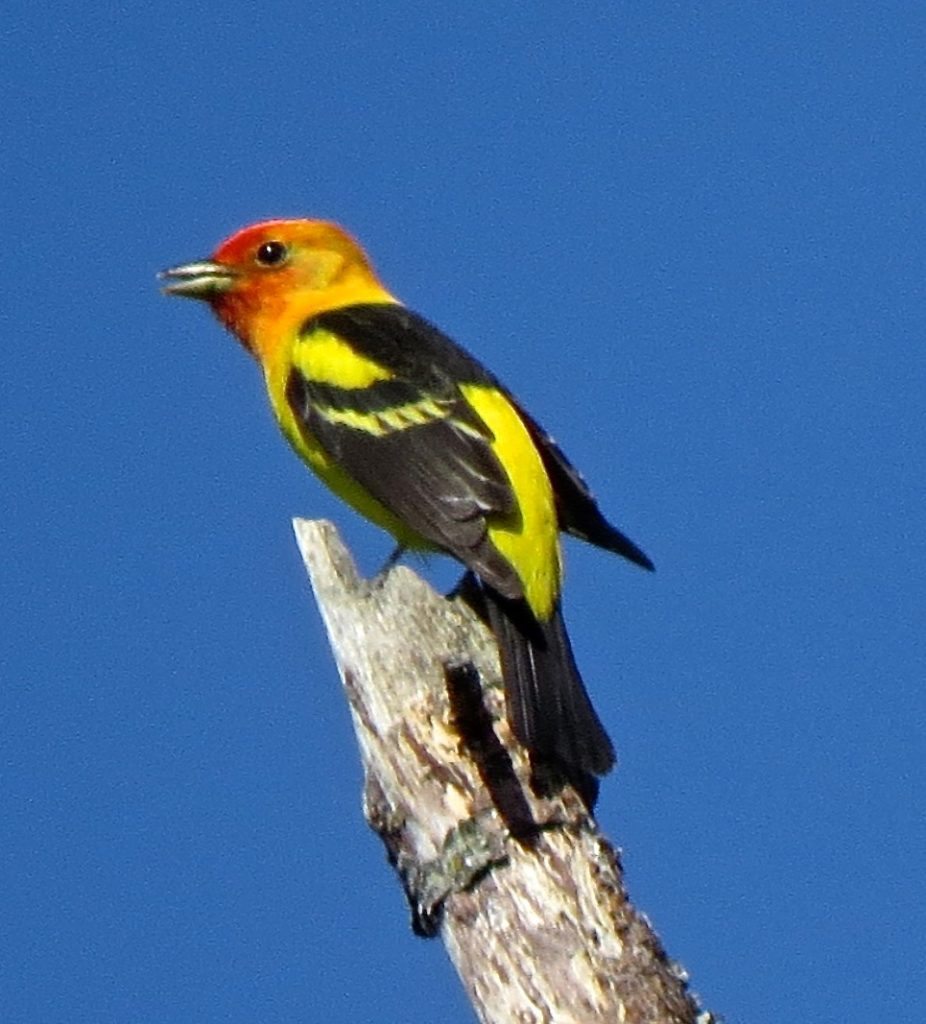
From the parking lot, head up the paved service road, enjoying the expansive view of the cities below. When you reach the top of the first grade there is a bench overlooking Orinda with views of Lake Cascade, Briones dam and hills, and the Diablo Valley to the east. Take note of the lone oak next to the bench, as it has hosted migrant warblers and other interesting songbirds in the past.
The pines and scrub along the flat portion of the ridge can produce a nice array of birds. A Green-tailed Towhee showed up here in 2012. Listen for Lazuli Bunting as well as other songbirds from the grassland below in spring. Don’t forget to watch the sky. At this elevation, swifts, falcons, Golden Eagles, and other raptors may fly by at eye-level. Bald Eagles or Ospreys moving between the local reservoirs are special sights.

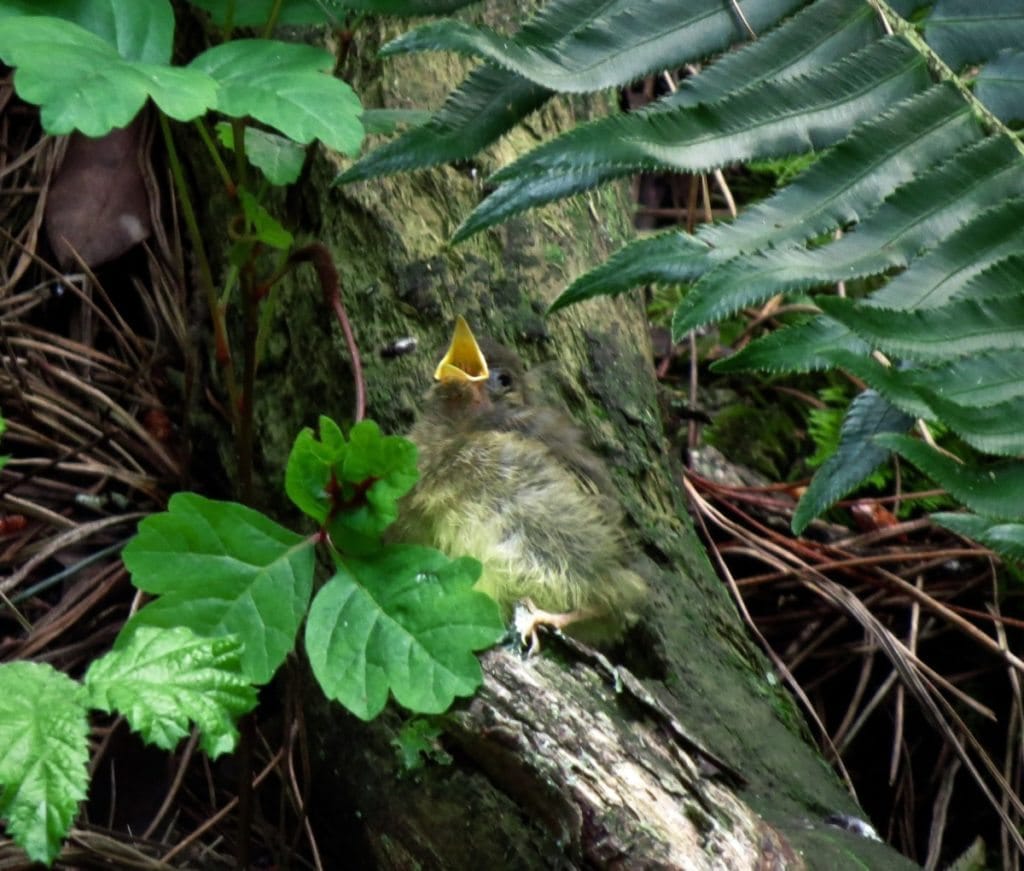
After passing the pines below the communication tower, the paved road veers left. The shaded road is lined with sword ferns, providing excellent habitat for Pacific Wren. Pygmy Nuthatches have nested in a snag behind this slope. I once heard what sounded to me like the “wit” call of a Hammond’s Flycatcher from the pines. When I heard Pygmy Nuthatches giving a similar call, I laughed at my mistake. Then, to my delight, I saw the Hammond’s Flycatcher high in the pines with the nuthatches!
In spring, Pacific-slope Flycatchers, Wilson’s Warblers, and singing MacGillivray’s Warblers are often here. The steep road heads up to the communication towers, where Olive-sided Flycatchers may sing from the top of the pines to the west.
Returning to the main Seaview Trail heading north, the road turns to dirt, clay and “Bald Peak” basalt – at 8.4 million years, the youngest volcanic rock in the Oakland area. Make sure to check the old, lone oak on the east side of the trail for birds. The coastal scrub on both sides of trail is excellent habitat for California Thrasher, Wrentit, and wintering sparrows.
Continuing north, House Wrens may be singing in summer in the eucalyptus grove on the west of the road. From the hillside to the east, you may hear the incessant “dear, dear dear” call of of Rufous-crowned Sparrows. Their lovely, complex song is common in spring, but beware: It can be confused with the song of a Lazuli Bunting, also found nearby.
The intersection of Seaview Trail and Big Springs Trail offers wonderful old snags, nesting sites for cavity-nesting birds. Check the vegetation around the base of the snags for warblers and sparrows.
Before heading back to Vollmer Peak and the parking lot, hike a bit farther north to the bench overlooking San Francisco, the Golden Gate Bridge, and the horizon beyond. This is one of my favorite places to rest, reflect, and find a moment of profound peace in the company of birds.
The Dawn Chorus Experience
Vollmer Peak offers good birding any time of year, but April and May is when birdsong really takes off. My Birding By Ear classes meet at 5:30 a.m. in almost complete darkness, listening for any sounds around us. Sometimes we hear a single call note or brief song from a Song Sparrow or Wrentit, or a bit of song and call from an American Robin. We often hear a Great Horned Owl give the typical five-note hoot, and occasionally hear the raspy, up-slurred call from a juvenile – always a crowd pleaser. On one occasion I heard a distant call of a Common Poorwill while waiting in the parking lot for my class to arrive.
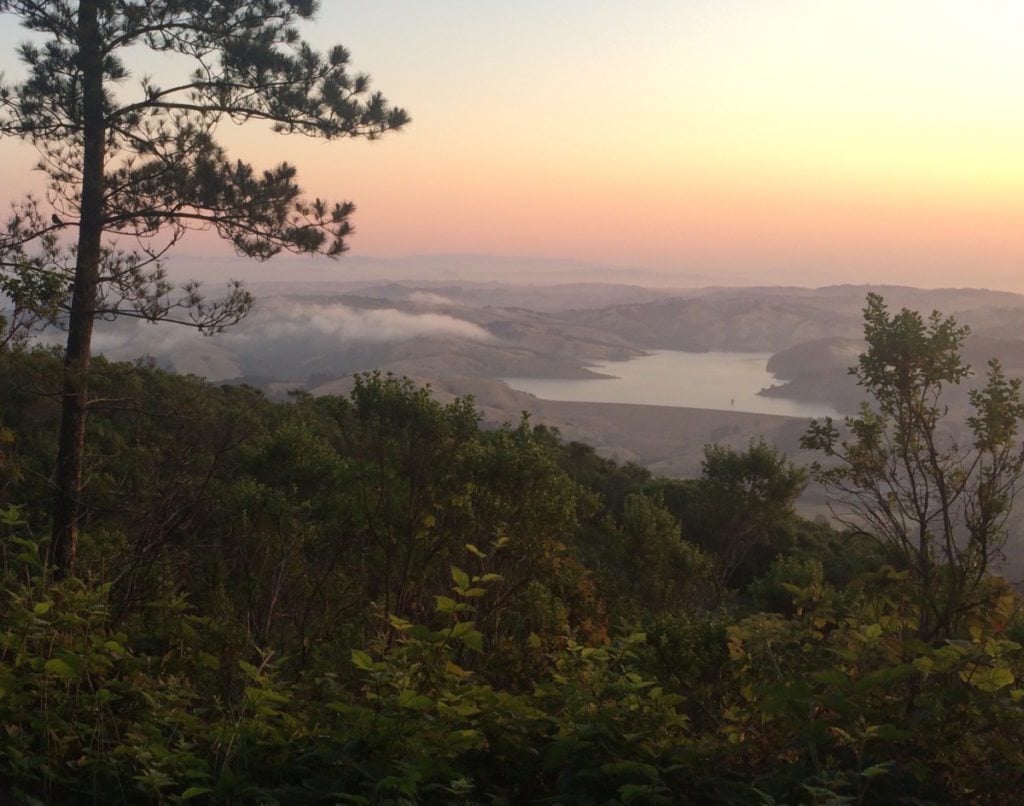
Hiking up the hill from the parking lot as the sky becomes lighter, more species begin to vocalize. As pre-dawn lightens up the landscape, bird calls surround us. If we’re lucky we might hear an Olive-sided Flycatcher singing its three-part dawn song, with shorter intervals between songs than during other times of day.
Western Bluebird and Ash-throated Flycatcher dawn songs are strikingly different from vocalizations heard during the day. As sunrise breaks to the north of Mount Diablo, birdsong quiets a bit but still fills the air. Of course, if it’s fogged-in or raining, it’s not quite the same. It’s less active, but there is still some birdsong and activity. I have seen a Lazuli Bunting in the fog, singing at eye-level within feet of me, its exquisite blue plumage glowing in the defused light.
The Dawn Chorus experience is possible in Tilden Park because the Park District allows people to enter as early as 5 a.m.. Other locations within the park can be just as satisfying to experience different species’ dawn songs.
Fast facts
Location: South end of Tilden Regional Park, above the Steam Trains.
Hours/Fees: 5 a.m. to10 p.m. No fees or permits required.
Ease of Access: Disabled accessible parking is available at the Steam Trains parking lot, but the paved portion of the Seaview Trail is steep. The dirt road beyond the paved road is rocky, and may be muddy with changes in elevation. Elevation is 1,654 feet at the parking lot and 1,905 feet. at the peak.
Arrive early, as the parking areas become congested later in the day, especially on weekends when the Steam Trains are running. Car break-ins are possible: Don’t leave valuables such as expensive optics in your vehicle.
Dogs, Bikes, Horses: Dogs are allowed on leash within 200 feet of the trail entrance and must be under voice control at all times. Bikes are allowed on the paved service road from the parking lot to the communication tower. Horses are allowed on the trails around Vollmer Peak.
Getting There:
Driving: Take your favorite route to Grizzly Peak Blvd. in the Berkeley Hills. Coming from Berkeley, one way is to take Marin Avenue, turn right onto Grizzly Peak, and then in 3.5 miles, turn left onto Lomas Cantatas. Or coming from San Francisco, take Highway 24 through he Caldecott Tunnel and exit immediately onto Fish Ranch Road. Take Fish Ranch up to Grizzly Peak, turn right onto Grizzly Peak for 1.2 miles, then right onto Lomas Cantatas.
Once you’re on Lomas Cantatas, make an immediate left and pass the parking lot for the stream trains. Go about 200 ft., veering right, slightly uphill and follow the sign to “Trailhead Parking.” If you find yourself in the maintenance parking lot, you’ve gone too far. See this Map of Tilden Regional Park.
Transit: AC Transit’s 67 bus goes from Berkeley BART to Brazilian Building. You can view the timetable here. It’s an uphill hike of about a mile to Vollmer Peak, via South Park Road and Big Springs Trail.
Nearby bathrooms: There is one port-a-potty in the upper parking lot and a restroom in the Steam Trains parking lot. No other restroom on the trails.
Nearby cafes/restaurants: No cafes or restaurants in the immediate area. Many to choose from in Berkeley or Oakland. Orinda to the east also has a few restaurants.
Habitat: Oak woodland, coastal scrub, pines, eucalyptus and a variety of planted exotics and native plants, and private pastures and grasslands to the east.
Key Birds:
Year-Round: Red-tailed Hawk, Nuttall’s Woodpecker, Hairy Woodpecker, Anna’s Hummingbird, Great Horned Owl, Hutton’s Vireo, California Scrub-Jay, Steller’s Jay, Common Raven, Pygmy Nuthatch, Red-breasted Nuthatch, Bewick’s Wren, Pacific Wren, Wrentit, Oak Titmouse Chestnut-backed Chickadee, Bushtit, American Robin, California Thrasher, California Towhee, Song Sparrow, Dark-eyed Junco, Lesser Goldfinch, Purple Finch, House Finch.
Summer: Allen’s Hummingbirds, Wilson’s Warbler, Lazuli Bunting
Winter: Hermit Thrush, Golden-crown Sparrow, White-crowned Sparrow, Yellow-rumped Warbler, Townsend’s Warbler
Spring/fall migrants: Warbling Vireo, Cassin’s Vireo, Blue-gray Gnatcatcher, Hermit Warbler, Black-throated Gray Warbler, Lazuli Bunting, Black-headed Grosbeak, Western Tanager, Chipping Sparrow.
For more information:
Map of Tilden Regional Park
History of the East Bay Regional Parks
Geology of Vollmer Peak
About August Vollmer:
Remembering August Vollmer
August Vollmer: Pioneer in Police Professionalism
An excellent source of information on Vollmer Peak is A Botanical Exploration of the Tilden Park Area of San Pablo Ridge, Contra Costa County, CA by S.W. Edwards – Four Seasons (annual journal of the Regional Parks Botanic Garden) – Volume 11, Number 4, December 2002. Contact the Regional Parks Botanic Garden at bgarden@ebparks.org or (510) 544-3169.
Denise Wight has been birding seriously since May 1986. She grew up and has lived in Contra Costa County most of her life, and has taught birding classes since 1996. She currently teaches the wildly popular Birding by Ear class for Golden Gate Bird Alliance. Her web site is denisewightbirds.com.
Denise will lead two Birding By Ear walks on Vollmer Peak on April 9, 2017 as part of Golden Gate Bird Alliance’s 2017 Birdathon. One is a dawn walk that starts at 5:30 a.m., and the other is a mid-morning walk at 9 a.m. Sign up and experience spring birdsong at Vollmer Peak firsthand… while raising money to protect Bay Area birds! Details and registration at goldengatebirdalliance.org/Birdathon2017-trips.
